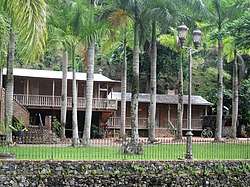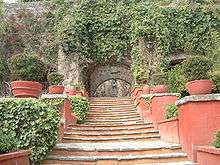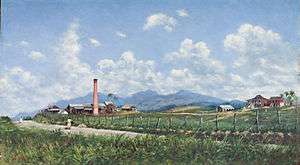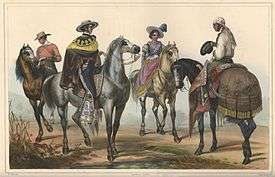Hacienda
A hacienda (UK: /ˌhæsiˈɛndə/ or US: /ˌhɑːsiˈɛndə/; Spanish: [aˈθjenda] or [aˈsjenda]), in the colonies of the Spanish Empire, is an estate (or finca), similar to a Roman latifundium. Some haciendas were plantations, mines or factories. Many haciendas combined these activities. The word is derived from the Spanish word "hacer" or "haciendo", which means: to make or be making, respectively; and were largely business enterprises consisting of various money making ventures including raising farm animals and maintaining orchards.

The term hacienda is imprecise, but usually refers to landed estates of significant size. Smaller holdings were termed estancias or ranchos that were owned almost exclusively by Spaniards and criollos and in rare cases by mixed-race individuals.[1] In Argentina, the term estancia is used for large estates that in Mexico would be termed haciendas. In recent decades, the term has been used in the United States to refer to an architectural style associated with the earlier estate manor houses.
The hacienda system of Argentina, Bolivia, Chile, Colombia, Guatemala, El Salvador, Mexico, New Granada, and Peru was a system of large land holdings. A similar system existed on a smaller scale in the Philippines and Puerto Rico. In Puerto Rico, haciendas were larger than estancias, ordinarily grew either sugar cane, coffee, or cotton, and exported their crops outside Puerto Rico.
Origins and growth
.jpg)
Haciendas originated in the Spanish colonization of the Americas as conquests followed a similar pattern in many places. As the Spanish established cities in the middle of conquered territories smaller plots of land were distributed in nearby while far-away areas were granted as large landholdings to conquistadores becoming haciendas and estancias.[2] Distribution of land happened in parallel to the distribution of indigenous people who entered servitude.[3] New haciendas were formed in many places in the 17th and 18th century as most local economies moved away from mining and into agriculture and husbandry.[4]
Haciendas were developed as profit-making, economic enterprises linked to regional or international markets. Although the hacienda is not directly linked to the early grants of indigenous American labor, the encomienda, many Spanish holders of encomiendas did acquire land or develop enterprises where they had access to that forced labor. Even though the private landed estates that constituted most haciendas did not have a direct tie to the encomienda, they are nonetheless linked. Encomenderos were in a position to retain their prominence economically via the hacienda. Since the encomienda was a grant from the crown, holders were dependent on the crown for its continuation. As the crown moved to eliminate the encomienda with its labor supply, Spaniards consolidated private landholdings and recruited free labor on a permanent or casual basis. The long term trend then was the creation of the hacienda as secure private property, which survived the colonial period and into the 20th century. Estates were integrated into a market-based economy aimed at the Hispanic sector and cultivated crops such as sugar, wheat, fruits and vegetables and produced animal products such as meat, wool, leather, and tallow.[5][6]
Haciendas originated in Spanish land grants, made to many conquistadors and crown officials, but many ordinary Spaniards could also petition for land grants from the crown. The system in Mexico is considered to have started when the Spanish Crown granted to Hernán Cortés the title of Marquis of the Valley of Oaxaca in 1529. It gave him a tract of land that included all of the present state of Morelos. Cortés was also granted encomiendas that gave him access to a vast pool of indigenous labor.
Personnel
In Spanish America, the owner of an hacienda was called the hacendado or patrón. Most owners of large and profitable haciendas preferred to live in Spanish cities, often near the hacienda, but in Mexico, the richest owners lived in Mexico City, visiting their haciendas at intervals.[7] Onsite management of the rural estates was by a paid administrator or manager, which was similar to the arrangement with the encomienda. Administrators were often hired for a fixed term of employment, receiving a salary and at times some share of the profits of the estate. Some administrators also acquired landholdings themselves in the area of the estate they were managing.[8]
The work force on haciendas varied, depending on the type of hacienda and where it was located. In central Mexico near indigenous communities and growing crops to supply urban markets, there was often a small, permanent workforce resident on the hacienda. Labor could be recruited from nearby indigenous communities on an as-needed basis, such as planting and harvest time.[6] The permanent and temporary hacienda employees worked land that belonged to the patrón and under the supervision of local labor bosses. In some places small scale cultivators or campesinos worked small holdings belonging to the hacendado, and owed a portion of their crops to him. In a number of places, the economy of the 18th century was largely a barter system, with little specie circulated on the hacienda.


Stock raising was central to ranching haciendas, the largest of which were in areas without dense indigenous populations, such as northern Mexico, but as indigenous populations declined in central areas, more land became available for grazing.[9] Livestock were animals originally imported from Spain, including cattle, horses, sheep, and goats were part of the Columbian Exchange and produced significant ecological changes. Sheep in particular had a devastating impact on the environment due to overgrazing.[10] Mounted ranch hands variously called vaqueros and gauchos (in the Southern Cone), among other terms worked for pastoral haciendas.
Where the hacienda included working mines, as in Mexico, the patrón might gain immense wealth. The unusually large and profitable Jesuit hacienda Santa Lucía, near Mexico City, established in 1576 and lasting to the expulsion in 1767, has been reconstructed by Herman Konrad from archival sources. This reconstruction has revealed the nature and operation of the hacienda system in Mexico, its labor force, its systems of land tenure and its relationship to larger Hispanic society in Mexico.
The Catholic Church and orders, especially the Jesuits, acquired vast hacienda holdings or preferentially loaned money to the hacendados. As the hacienda owners' mortgage holders, the Church's interests were connected with the landholding class. In the history of Mexico and other Latin American countries, the masses developed some hostility to the church; at times of gaining independence or during certain political movements, the people confiscated the church haciendas or restricted them.
Haciendas in the Caribbean were developed primarily as sugar plantations, dependent on the labor of African slaves imported to the region, were staffed by slaves brought from Africa.[11] In Puerto Rico, this system ended with the abolition of slavery on 22 March 1873.[12]
South American haciendas
In South America, the hacienda remained after the collapse of the colonial system in the early 19th century when nations gained independence. In some places, such as Dominican Republic, with independence came efforts to break up the large plantation holdings into a myriad of small subsistence farmers' holdings, an agrarian revolution. In Argentina and elsewhere, a second, international, money-based economy developed independently of the haciendas, which sank into rural poverty.
In most of Latin America, the old holdings remained. In Mexico, the haciendas were abolished by law in 1917 during the revolution, but remnants of the system affect Mexico today. In rural areas, the wealthiest people typically affect the style of the old hacendados even though their wealth these days derives from more capitalistic enterprises.
In Bolivia, haciendas were prevalent until the 1952 Revolution of Víctor Paz Estenssoro. He established an extensive program of land distribution as part of the Agrarian Reform. Likewise, Peru had haciendas until the Agrarian Reform (1969) of Juan Velasco Alvarado, who expropriated the land from the hacendados and redistributed it to the peasants.
Chile
The first haciendas of Chile formed during the Spanish conquest in the 16th century.[3] The Destruction of the Seven Cities following the battle of Curalaba (1598) meant for the Spanish the loss of both the main gold districts and the largest sources of indigenous labour.[13] After those dramatic years the colony of Chile became concentrated in Central Chile which became increasingly populated, explored and economically exploited.[4] Much land in Central Chile was cleared with fire during this period.[14] On the contrary open fields in southern Chile were overgrown as indigenous populations declined due to diseases introduced by the Spanish and intermittent warfare.[15] The loss of the cities meant Spanish settlements in Chile became increasingly rural[16] with the hacienda gaining importance in economic and social matters.[17] As Chilean mining activity declined in the 17th century[18] more haciendas were formed as the economy moved away from mining and into agriculture and husbandry.[4]
Beginning in the late 17th century Chilean haciendas begun to export wheat to Peru. While the immediate cause of this was Peru being struck by both an earthquake and a stem rust epidemic,[19] Chilean soil and climatic conditions were better for cereal production than those of Peru and Chilean wheat was cheaper and of better quality than Peruvian wheat.[19][20] Initially Chilean haciendas could not meet the wheat demand due to a labour shortage, so had to incorporate temporary workers in addition to the permanent staff. Another response by the latifundia to labour shortages was to act as merchants, buying wheat produced by independent farmers or from farmers that hired land. In the period 1700 to 1850, this second option was overall more lucrative.[21] It was primarily the haciendas of Central Chile, La Serena and Concepción that came to be involved in cereal export to Peru.[19]
In the 19th and early 20th century haciendas were the main prey for Chilean banditry.[22] 20th century Chilean haciendas stand out for the poor conditions of workers[23] and being a backward part of the economy.[24][25] The hacienda and inquilinaje institutions that characterized large parts of Chilean agriculture were eliminated by the Chilean land reform (1962–1973).[26]
Other locations
Philippines
In the Philippines, the hacienda system and lifestyles were influenced by the Spanish colonization that occurred via Mexico for more than 300 years. Attempts to break up the hacienda system in the Philippines through land reform laws during the second half of the 1900s have not been successful. There were protests related to the Hacienda Luisita.[27]
Puerto Rico

Haciendas in Puerto Rico developed during the time of Spanish colonization. An example of these was the 1833 Hacienda Buena Vista, which dealt primarily with the cultivation, packaging, and exportation of coffee.[28] Today, Hacienda Buena Vista, which is listed in the United States National Register of Historic Places, is operated as a museum, Museo Hacienda Buena Vista.[29]
The 1861 Hacienda Mercedita was a sugar plantation that once produced, packaged and sold sugar in the Snow White brand name.[30] In the late 19th century, Mercedita became the site of production of Don Q rum.[31] Its profitable rum business is today called Destilería Serrallés.[32] The last of such haciendas decayed considerably starting in the 1950s, with the industrialization of Puerto Rico via Operation Bootstrap.[33][34] At the turn of the 20th century, most coffee haciendas had disappeared.
The sugar-based haciendas changed into centrales azucarelas.[35] Yet by the 1990s, and despite significant government fiscal support, the last 13 Puerto Rican centrales azucares were forced to shut down. This marked the end of haciendas operating in Puerto Rico.[36] In 2000, the last two sugar mills closed, after having operated for nearly 100 years.[35][37]
An "estancia" was a similar type of food farm. An estancia differed from an hacienda in terms of crop types handled, target market, machinery used, and size. An estancia, during Spanish colonial times in Puerto Rico (1508[38] - 1898),[lower-alpha 1] was a plot of land used for cultivating "frutos menores" (minor crops).[39] That is, the crops in such estancia farms were produced in relatively small quantities and thus were meant, not for wholesale or exporting, but for sale and consumption locally, where produced and its adjacent towns.[40] Haciendas, unlike estancias, were equipped with industrial machinery used for processing its crops into derivatives such as juices, marmalades, flours, etc., for wholesale and exporting.[41] Some "frutos menores" grown in estancias were rice, corn, beans, batatas, ñames, yautías, and pumpkins;[42] among fruits were plantains, bananas, oranges, avocados, and grapefruits.[43] Most haciendas in Puerto Rico produced sugar, coffee, and tobacco, which were the crops for exporting.[44] Some estancias were larger than some haciendas, but generally this was the exception and not the norm.[45]
Other meanings
In the present era, the Ministerio de Hacienda is the government department in Spain that deals with finance and taxation, as in Mexico Secretaría de Hacienda y Crédito Público, and which is equivalent to the Department of the Treasury in the United States or HM Treasury in the United Kingdom.
List of haciendas
- Hacienda Cocoyoc (Mexico)
- Hacienda Buena Vista (Puerto Rico)
- Hacienda Juriquilla (Mexico)
- Hacienda Luisita (Philippines)
- Hacienda Mercedita (Puerto Rico)
- Hacienda Napoles (Colombia)
- Hacienda San Antonio de Petrel (Chile)
- Palacio San José (Argentina)
- Hacienda San Jose Chactún (Mexico)
- Hacienda Yorba (USA)
- Sánchez Navarro latifundio (Mexico)
See also
- Cortijo
- Encomienda
- Estancia
- Fazenda
- Feudalism
- Mit'a#Spanish rule, a form of tribute to the Inca government in the form of labor, abused by the Spanish Viceroyalty of Peru
- Plantation
- Ranch
- Repartimiento, a colonial forced labor system imposed upon the indigenous population of Spanish America and the Philippines
- Roman villa
- "My Adobe Hacienda"
Notes
- After the change of sovereignty in 1898 from Spain to the United States as a result of the Spanish-American War, and the ensuing industrialization and development of a manufacturing- and services-based society of the mid 20th century, both haciendas and estancias gradually diminished to almost non-existent.
References
- Ida Altman, et al., The Early History of Greater Mexico, Pearson, 2003, p. 164.
- Villalobos et al. 1974, p. 87.
- Villalobos et al. 1974, pp. 109–113.
- Villalobos et al. 1974, pp. 160–165.
- James Lockhart, "Encomienda and Hacienda: The Evolution of the Great Estate in the Spanish Indies," Hispanic American Historical Review, 1969, 59: 411-29,
- James Lockhart and Stuart Schwartz, Early Latin America: A History of Colonial Spanish America and Brazil, Cambridge: Cambridge University Press, 1983, pp. 134–142.
- Ricardo Rendón Garcini, Daily Life on the Haciendas of Mexico, Banamex-Accova;S/A/ de C.V., Mexico: 1998, p. 31.
- Altman et al. (2003), The Early History of Greater Mexico, pp. 165–66.
- Altman et al. (2003), The Early History of Greater Mexico, p. 163.
- Elinor G. K. Melville, A Plague of Sheep: Environmental Consequences of the Conquest of Mexico," Cambridge, Cambridge University Press, 1997.
- African Aspects of the Puerto Rican Personality by (the late) Dr. Robert A. Martinez, Baruch College. (Archived from the original on 20 July 2007). Retrieved 13 July 2012.
- "Abolition of Slavery (1873)" Archived 8 July 2012 at the Wayback Machine. Encyclopedia Puerto Rico. 2012. Fundación Puertorriqueña de las Humanidades. Retrieved 20 November 2012.
- Salazar & Pinto 2002, p. 15.
- Rozas, Vicente; Le-Quesne, Carlos; Rojas-Badilla, Moisés; González, Mauro E.; González-Reyes, Álvaro (2018). "Coupled human-climate signals on the fire history of upper Cachapoal Valley, Mediterranean Andes of Chile, since 1201 CE". Global and Planetary Change. 167: 137–147. doi:10.1016/j.gloplacha.2018.05.013.
- Otero 2006, p. 25.
- Lorenzo 1986, p. 158.
- Lorenzo 1986, p. 159.
- Villalobos et al. 1974, p. 168.
- Villalobos et al., 1974, pp. 155–160.
- Collier, Simon and Sater William F. 2004. A History of Chile: 1808-2002 Cambridge University Press. p. 10.
- Gabriel Salazar. 2000. Labradores, Peones y Proletarios. pp. 40–41
- "Bandidaje rural en Chile central (1820-1920)". Memoria Chilena (in Spanish). Biblioteca Nacional de Chile. Retrieved 30 May 2014.
- Salazar & Pinto 2002, pp. 106–107.
- Ducoing Ruiz, C. A. (2012), Capital formation in machinery and industrialization. Chile 1844–1938 (PDF)
- McCutchen McBride, George (1936), Wright, J. K. (ed.), Chile: Land and Society, New York: American Geographical Society, p. 177
- Rytkönen, P. Fruits of Capitalism: Modernization of Chilean Agriculture, 1950-2000. Lund Studies in Economic History, 31, p. 43.
- https://kahimyang.com/kauswagan/articles/1819/corys-carp-hacienda-luisita-and-the-roppongi-street-tokyo-property-controversy
- Robert Sackett, Preservationist, PRSHPO (original 1990 draft). Arleen Pabon, Certifying Official and State Historic Preservation Officer, State Historic Preservation Office, San Juan, Puerto Rico. 9 September 1994. In National Register of Historic Places Registration Form—Hacienda Buena Vista. United States Department of the Interior. National Park Service (Washington, D.C.), p. 16.
- Exotic Vernacular: Hacienda Buena Vista in Puerto Rico. Aaron Betsky. "Beyond Buildings," Architect: The Magazine of the American Institute of Architects. Retrieved 13 July 2012.
- Nydia R. Suarez. The Rise and Decline of Puerto Rico's Sugar Industry. Sugar and Sweetener: S&O/SSS-224. Economic Research Service, United States Department of Agriculture, December 1998, p. 25.
- Rum: The Epic Story of the Drink That Conquered the World. Charles A. Coulombe. New York: Kensington Publishing, 2004, p. 99. Retrieved 13 July 2012.
- "Our History". Destileria Serralles. Ponce, Puerto Rico. Retrieved 13 July 2012.
- "Operation Bootstrap (1947)" Archived 8 July 2012 at the Wayback Machine. Encyclopedia Puerto Rico. "History and Archaeology." Fundación Puertorriqueña para las Humanidades. Retrieved 13 July 2012.
- Informes Publicados: Central y Refinería Mercedita. Archived 18 June 2008 at the Wayback Machine Estado Libre Asociado de Puerto Rico. Oficina del Controlador. Corporación Azucarera de Puerto Rico. San Juan, Puerto Rico. Informe Número: CP-98-17 (23 June 1998). Released 1 July 1998. Retrieved 13 July 2012.
- "Economy: Sugar in Puerto Rico" Archived 16 June 2010 at the Wayback Machine, Encyclopedia Puerto Rico, "Economy." Fundación Puertorriqueña para las Humanidades. Retrieved 13 July 2012.
- Suarez (1998), The Rise and Decline of Puerto Rico's Sugar Industry, p. 31.
- Benjamin Bridgman, Michael Maio, James A. Schmitz, Jr. "What Ever Happened to the Puerto Rican Sugar Manufacturing Industry?", Federal Reserve Bank of Minneapolis, Staff Report 477, 2012.
- Guaynabo, Puerto Rico. Accessed 9 July 2019.
- Guillermo A. Baralt. Buena Vista: Life and work in a Puerto Rican Hacienda, 1833-1904. Translated from the Spanish by Andrew Hurley. (Originally published in 1988 by Fideicomiso de Conservación de Puerto Rico as La Buena Vista: Estancia de Frutos Menores, fabrica de harinas y hacienda cafetalera.) 1999. Chapel Hill, North Carolina, USA: University of North Carolina Press. p. iii. ISBN 0807848018
- Guillermo A. Baralt. Buena Vista: Life and work in a Puerto Rican Hacienda, 1833-1904. Translated from the Spanish by Andrew Hurley. (Originally published in 1988 by Fideicomiso de Conservación de Puerto Rico as La Buena Vista: Estancia de Frutos Menores, fabrica de harinas y hacienda cafetalera.) 1999. Chapel Hill, North Carolina, USA: University of North Carolina Press. p. 1. ISBN 0807848018
- Guillermo A. Baralt. Buena Vista: Life and work in a Puerto Rican Hacienda, 1833-1904. Translated from the Spanish by Andrew Hurley. (Originally published in 1988 by Fideicomiso de Conservación de Puerto Rico as La Buena Vista: Estancia de Frutos Menores, fabrica de harinas y hacienda cafetalera.) 1999. Chapel Hill, North Carolina, USA: University of North Carolina Press. p. 1. ISBN 0807848018
- Guillermo A. Baralt. Buena Vista: Life and work in a Puerto Rican Hacienda, 1833-1904. Translated from the Spanish by Andrew Hurley. (Originally published in 1988 by Fideicomiso de Conservación de Puerto Rico as La Buena Vista: Estancia de Frutos Menores, fabrica de harinas y hacienda cafetalera.) 1999. Chapel Hill, North Carolina, USA: University of North Carolina Press. p. 1. ISBN 0807848018
- Eduardo Neumann Gandia. Verdadera y Autentica Historia de la Ciudad de Ponce: Desde sus primitivos tiempos hasta la época contemporánea. San Juan, Puerto Rico: Instituto de Cultural Puertorriqueña. 1913. Reprinted 1987. p. 67.
- Eduardo Neumann Gandia. Verdadera y Autentica Historia de la Ciudad de Ponce: Desde sus primitivos tiempos hasta la época contemporánea. San Juan, Puerto Rico: Instituto de Cultural Puertorriqueña. 1913. Reprinted 1987. p. 67.
- Ivette Perez Vega. Las Sociedades Mercantiles de Ponce (1816-1830). Academia Puertorriqueña de la Historia. San Juan, PR: Ediciones Puerto. 2015. p. 389.ISBN 9781617900563
Further reading
General
- Mörner, Magnus. "The Spanish American Hacienda: A Survey of Recent Research and Debate," Hispanic American Historical Review (1973), 53#2, pp. 183–216 in JSTOR
- Van Young, Eric, "Mexican Rural History Since Chevalier: The Historiography of the Colonial Hacienda," Latin American Research Review, 18 (3) 1983; 5-61.
- Villalobos, Sergio; Silva, Osvaldo; Silva, Fernando; Estelle, Patricio (1974). Historia De Chile (14th ed.). Editorial Universitaria. ISBN 956-11-1163-2.
Haciendas in Mexico
- Bartlett, Paul Alexander. The Haciendas of Mexico: An Artist's Record. Niwot, CO: University Press of Colorado, 1990 in Project Gutenberg
- Bauer, Arnold. "Modernizing landlords and constructive peasants: In the Mexican countryside", Mexican Studies / Estudios Mexicanos (Winter 1998), 14#1, pp. 191–212.
- D. A. Brading, Haciendas and Ranchos in the Mexican Bajío. Cambridge and New York: Cambridge University Press, 1978.
- Chevalier, François. Land and Society in Colonial Mexico. Berkeley: University of California Press, 1963.
- Florescano, Enrique. "The Hacienda in New Spain." In Leslie Bethell (ed.), The Cambridge History of Latin America, vol. 4, Cambridge and New York: Cambridge University Press, 1984.
- Florescano, Enrique. Precios de maíz y crisis agrícolas en México, 1708 – 1810. Mexico City: Colegio de México, 1969.
- Gibson, Charles. The Aztecs Under Spanish Rule. Stanford: Stanford University Press, 1964.
- Harris, Charles H. A Mexican Family Empire: The Latifundio of the Sánchez Navarros, 1765 – 1867. Austin: University of Texas Press, 1975, ISBN 0-292-75020-X.
- Konrad, Herman W. A Jesuit Hacienda in Colonial Mexico: Santa Lucía, 1576–1767. Stanford: Stanford University Press, 1980.
- Lockhart, James. "Encomienda and Hacienda: The Evolution of the Great Estate in the Spanish Indies," Hispanic American Historical Review, 1969, 59: 411–29,
- Miller, Simon. Landlords and Haciendas in Modernizing Mexico. Amsterdam: CEDLA, 1995.
- Morin, Claude. Michoacán en la Nueva España del Siglo XVIII: Crecimiento y dissigualidad en una economía colonial. Mexico City: Fondo de Cultura Económica, 1979.
- Schryer, Frans J. The Rancheros of Pisaflores. Toronto: University of Toronto Press, 1978.
- Taylor, William B. Landlord and Peasant in Colonial Oaxaca. Stanford: Stanford University Press, 1972.
- Tayor, William B. "Landed Society in New Spain: A View from the South," Hispanic American Historical Review (1974), 54#3, pp. 387–413 in JSTOR
- Tutino, John. From Insurrection to Revolution in Mexico. Princeton: Princeton University Press, 1986.
- Van Young, Eric. Hacienda and Market in Eighteenth-Century Mexico. Berkeley: University of California Press, 1981.
- Wasserman, Mark. Capitalists, Caciques, and Revolution. Chapel Hill: University of North Carolina Press, 1984.
- Wells, Allen. Yucatán's Gilded Age. Albuquerque: University of New Mexico Press, 1985.
Haciendas in Puerto Rico
- Balletto, Barbara Insight Guide Puerto Rico
- De Wagenheim, Olga J. Puerto Rico: An Interpretive History from Precolumbia Times to 1900
- Figueroa, Luis A. Sugar, Slavery and Freedom in Nineteenth Century Puerto Rico
- Scarano, Francisco A. Sugar and Slavery in Puerto Rico: The Plantation Economy of Ponce, 1800–1850
- Schmidt-Nowara, Christopher Empire and Antislavery: Spain, Cuba and Puerto Rico, 1833–1874
- Soler, Luis M. D. Historia de la esclavitud negra en Puerto Rico
South America
- Lyons, Barry J. Remembering the Hacienda: Religion, Authority and Social Change in Highland Ecuador (2006)
- Lorenzo, Santiago (1986) [1983]. Origen de las ciudades chilenas: Las fundaciones del siglo XVIII (in Spanish) (2nd ed.). Santiago de Chile. p. 158.
- Salazar, Gabriel; Pinto, Julio (2002). Historia contemporánea de Chile III. La economía: mercados empresarios y trabajadores. LOM Ediciones. ISBN 956-282-172-2.

